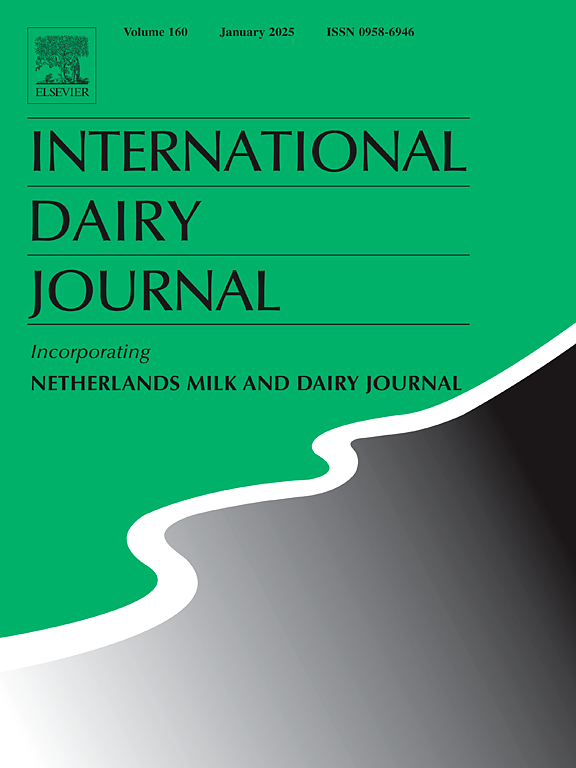婴儿配方蛋白构象变化:乳清蛋白组成和加工步骤的影响
IF 3.4
3区 农林科学
Q2 FOOD SCIENCE & TECHNOLOGY
引用次数: 0
摘要
本工作研究了婴儿配方奶粉(IMF)加工步骤对蛋白质构象的累积效应。以不同比例的β-乳球蛋白(β-Lg): α-乳清蛋白(α-Lac):乳铁蛋白(Lf):骨桥蛋白(OPN)制备模型体系:FC (69.6: 27.9: 2.1: 0.4), F1(39.6: 57.9: 2.1: 0.4)和F2(0: 57.4: 39.9: 2.7)。通过本征荧光、电泳和有效赖氨酸监测蛋白质结构变化。乳清蛋白(WP)组成影响蛋白质聚集的程度、类型和化学计量。密度分析显示,FC、F1和F2分别保留了20.5±2.8%、30.2±6.7%和54.8±3.7%的天然乳清蛋白。在所有配方中,巴氏灭菌阶段对集合体的形成影响最大。均质化效果似乎与WP成分无关。荧光强度数据显示,在巴氏灭菌、蒸发和较小程度的喷雾干燥过程中,成分依赖。最后,IMFs之间的成分差异影响了干燥诱导的赖氨酸糖基化,其中F2显示出最大的乳糖基化率(23.5%),可能是因为lf诱导的酪蛋白解离。这些发现强调了加工步骤和IMF组成作为蛋白质构象驱动因素之间的相互作用。本文章由计算机程序翻译,如有差异,请以英文原文为准。
Conformational changes of infant formula proteins: effect of whey protein composition and processing step
This work investigated the cumulative effect of infant milk formula (IMF) processing steps on protein conformation. Model systems were prepared with varying β-Lactoglobulin (β-Lg): α-Lactalbumin (α-Lac): Lactoferrin (Lf): Osteopontin (OPN) ratios: FC (69.6 : 27.9: 2.1 : 0.4), F1 (39.6 : 57.9: 2.1 : 0.4), and F2 (0 : 57.4: 39.9 : 2.7). Protein structural changes were monitored by intrinsic fluorescence, electrophoresis, and available lysine. Whey protein (WP) composition influenced the extent, type, and stoichiometry of protein aggregation. Densitometric analysis revealed that FC, F1, and F2 retained 20.5 ± 2.8 %, 30.2 ± 6.7 %, and 54.8 ± 3.7 % of the native-like whey protein, respectively. Across all formulations, the pasteurization stage held the greatest influence in aggregate formation. Homogenization effects appear to be independent of WP composition. Fluorescence intensity data showed compositional dependence during pasteurization, evaporation, and to a lesser extent, spray drying. Finally, compositional differences between IMFs affected drying-induced lysine glycation, with F2 showing the greatest rate of lactosylation (23.5 %) presumably because of Lf-induced casein dissociation. These findings highlight the interplay between processing steps and IMF composition as drivers of protein conformation.
求助全文
通过发布文献求助,成功后即可免费获取论文全文。
去求助
来源期刊

International Dairy Journal
工程技术-食品科技
CiteScore
6.50
自引率
9.70%
发文量
200
审稿时长
49 days
期刊介绍:
The International Dairy Journal publishes significant advancements in dairy science and technology in the form of research articles and critical reviews that are of relevance to the broader international dairy community. Within this scope, research on the science and technology of milk and dairy products and the nutritional and health aspects of dairy foods are included; the journal pays particular attention to applied research and its interface with the dairy industry.
The journal''s coverage includes the following, where directly applicable to dairy science and technology:
• Chemistry and physico-chemical properties of milk constituents
• Microbiology, food safety, enzymology, biotechnology
• Processing and engineering
• Emulsion science, food structure, and texture
• Raw material quality and effect on relevant products
• Flavour and off-flavour development
• Technological functionality and applications of dairy ingredients
• Sensory and consumer sciences
• Nutrition and substantiation of human health implications of milk components or dairy products
International Dairy Journal does not publish papers related to milk production, animal health and other aspects of on-farm milk production unless there is a clear relationship to dairy technology, human health or final product quality.
 求助内容:
求助内容: 应助结果提醒方式:
应助结果提醒方式:


